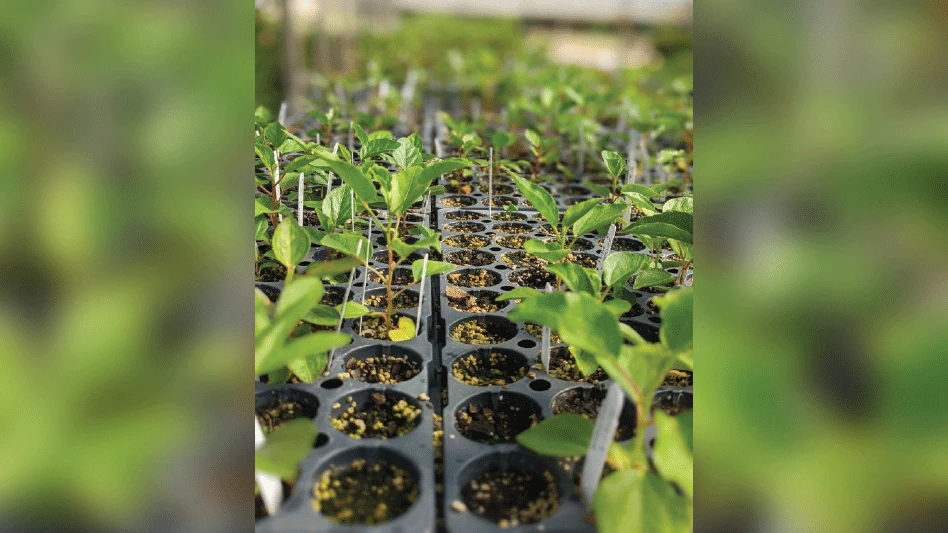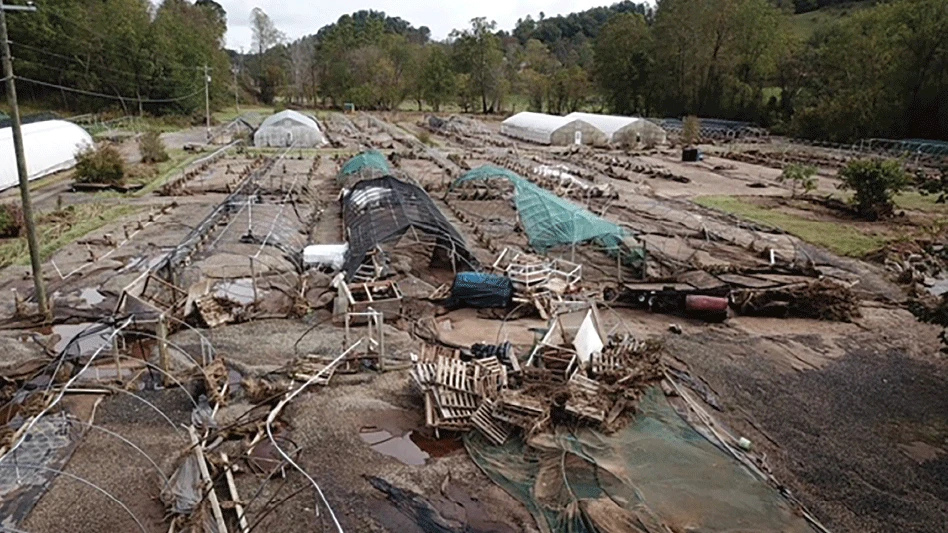 Equisetum and other plants that tolerate poor drainage and wet conditions are placed in drainage areas to take up water and soluble nutrients and pesticides in these vegetated bioswales. The plants are periodically harvested as a crop.Growers must implement practices to protect water resources and comply with increasing regulations. Installation of vegetated buffers is one method that can be used to prevent pollutants, such as fertilizers, pesticides and container media, from ending up in surface and groundwater.
Equisetum and other plants that tolerate poor drainage and wet conditions are placed in drainage areas to take up water and soluble nutrients and pesticides in these vegetated bioswales. The plants are periodically harvested as a crop.Growers must implement practices to protect water resources and comply with increasing regulations. Installation of vegetated buffers is one method that can be used to prevent pollutants, such as fertilizers, pesticides and container media, from ending up in surface and groundwater.
Buffer benefits
Vegetated buffers are areas or strips of land maintained in permanent vegetation to prevent erosion and improve water quality by trapping and treating contaminants. Vegetated buffers can also provide other benefits, including enhancing wildlife habitat, increasing beneficial insects for biological control of crop pests and protecting stream banks. The buffers can also be used for green waste and secondary crop production.
Types of vegetated buffers
Vegetated bioswale. A vegetated bioswale is a stormwater conveyance system that channels stormwater. This type of buffer system improves water quality by reducing flow velocity and increasing sedimentation, filtering pollutants and allowing infiltration into underlying soils.
Filter strip. A filter strip is a band of vegetation that can be used between a greenhouse and a water body. The purpose of the filter strip is to slow runoff from the production area and trap sediment, fertilizers and pesticides before they reach surface water.
Constructed wetlands. A constructed wetland is an artificial marsh or swamp for treating wastewater, controlling flood waters and reducing erosion. Wetlands can be built to further remove pollutants in the effluent from a retention basin.
How vegetated buffers work
Although there are different types of vegetated buffer systems, most work in a similar manner. Runoff containing soluble nutrients, pesticides and sediments with adsorbed pesticides, enters the buffer. Vegetation in the buffer slows surface flow and sediments drop out. Some water infiltrates into the root zone and subsoil, while the remainder becomes lateral subsurface flow.
When the roots of buffer plants grow to sufficient depth, they intercept infiltrated water, taking up the soluble nutrients and pesticides. Pesticides adsorbed to soil particles become trapped in the root zone and high soil organic matter provides conditions for denitrification and pesticide degradation.
Site selection and design
When planning and designing a vegetative buffer, it is best to consult a licensed engineer or the Natural Resources Conservation Service. Buffers need to be designed and constructed to comply with all federal, state and local laws and regulations.
Plant selection
Plant species that are used in buffers should be selected based on their adaptability and tolerance to site conditions. Check local information sources, such as the NRCS and cooperative extension service, before making selections.
Plant selection should be based on climatic and microclimatic adaptability, including plant hardiness and heat tolerance. Seasonal rainfall is also important, especially if supplemental irrigation isn’t planned for dry seasons.
Soil and root media conditions need to be considered, including soil type and depth to water table. If plants are grown in irrigation channels or constructed wetlands, it is essential that plant species are selected that can tolerate standing water and low root aeration.
Cost of plants is an important factor in plant selection. Plants used in buffers are typically seeded, as this is generally the least expensive method. It is important to figure in the extra labor involved in weed control during the establishment of seedlings, as compared to transplanting plugs or liners or larger container plants that are purchased or produced on-site.
Growth rate and season of growth are also important factors in plant selection. Growth during seasonal storms is important in the uptake of pollutants generated during these events. Plants that grow rapidly are easier to establish and can take up more nutrients from runoff. However, consider pruning, mowing and other maintenance tasks associated with rapid growth.
Secondary crops
Some growers have successfully used vegetative buffers to produce secondary crops. It is important that there is a market for the selected plants or cut flowers and foliage harvested from the buffer, and that the market price will offset at least some of the production and maintenance costs. Growers who are interested in developing techniques to produce secondary crops in vegetative treatment systems should contact the cooperative extension service and NRCS for guidance.
Planting and maintenance
Planting should be timed so buffers are established prior to expected runoff. The use of mulch or straw dikes may be necessary to protect vegetation until it is established. Supplemental irrigation may also be warranted, especially to promote seed germination and vegetation establishment. Continuous protection from vehicular traffic is critical.
Maintenance of vegetative buffers is necessary to sustain buffer function and effectiveness. Buffers should be inspected regularly, especially after storm events. Damaged areas should be immediately repaired.
Trapped sediment changes buffer shape and may cause runoff to flow parallel to buffers rather than across them. Periodically remove sediment and reshape the buffers. Dredge ditches lined with plants before seasonal storms.
Vegetative buffers require management of pests such as noxious weeds and invasive plant species, insects and vertebrates.
Insect pests in buffers that can move into production areas may require treatment. However, vegetated buffers can also harbor beneficial insects. Beware of mosquitoes in buffer areas with standing water. If chemical treatments are necessary to control pests, consider potential risks to adjacent aquatic ecosystems.
Mowing and pruning may be necessary to control plant growth and weeds, and for aesthetic reasons. Mowing can stimulate growth and biological activity, leading to increased nutrient uptake and pesticide degradation. Conversely, it can increase runoff flow and cause injury to some species if the mowing height is too short.
Periodic harvesting of vegetation used in buffers removes trapped pesticides and nutrients from the system, preventing eventual release to the soil and potential movement to water bodies. Harvested plant material can potentially be marketed or used to produce compost.
Julie Newman is environmental horticulture farm adviser, University of California Cooperative Extension, jpnewman@ucdavis.edu.
Get curated news on YOUR industry.
Enter your email to receive our newsletters.
Explore the February 2010 Issue
Check out more from this issue and find your next story to read.
Latest from Nursery Management
- November issue recap
- Trump threatens 25% tariffs on Mexico and Canada in move that could hurt horticulture
- Hold the line!
- Meet the All-America Selections AAS winners for 2025
- Exacto announces David Hollinrake as CEO
- AmericanHort accepting applications for HortScholars program at Cultivate'25
- BioWorks hires Curt Granger as business development manager for specialty agriculture
- 2025 Farwest Show booth applications now open







